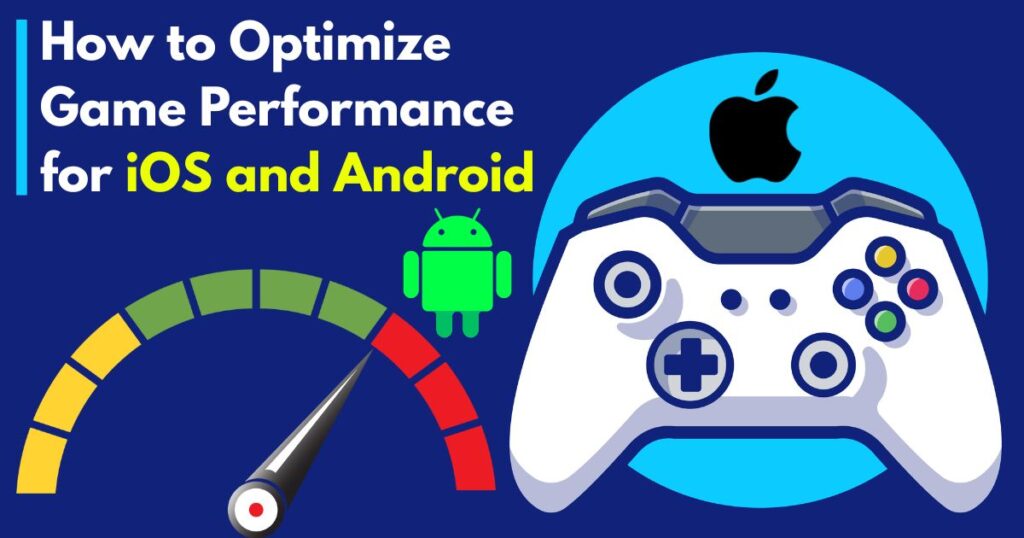Mobile gaming continues to dominate the app industry, accounting for nearly 49% of global gaming revenue in 2024, according to Statista. With over 3.3 billion smartphone gamers worldwide, optimizing performance for iOS and Android platforms has become critical for both user satisfaction and app store rankings.
Whether you’re building a high-fidelity 3D action game or a casual 2D puzzle, ensuring smooth performance is vital. This guide offers actionable insights and proven strategies from industry experts. If you’re planning to build a mobile game, it is crucial to hire custom game developer teams who understand both the hardware limitations and performance optimization techniques specific to each platform.
Why Performance Optimization Matters
Performance affects user experience, retention, and reviews. A game that lags, crashes, or drains the battery will not survive the competition.
Key outcomes of poor performance:
- High uninstall rates within the first 5 minutes
- Poor app store reviews, reducing organic installs
- Increased device overheating and battery drain
- Frame rate drops and input lag, ruining gameplay
A reliable hire custom game developer strategy involves planning for performance from day one.
Platform-Specific Considerations
iOS Performance Factors
- Limited range of devices, but high expectations from users
- Metal API is preferred over OpenGL for graphics
- iOS aggressively manages memory; misuse can cause instant crashes
Android Performance Factors
- Thousands of device variants with different hardware profiles
- Fragmented OS versions (Android 10 to 14)
- Different GPU and CPU vendors (Qualcomm, MediaTek, Exynos)
Optimization on Android requires additional profiling and adaptation for various hardware classes.
General Techniques for Mobile Game Optimization
1. Frame Rate Optimization
Target frame rate:
- 60 FPS for most games
- 30 FPS for complex games on low-end devices
Reduce draw calls by:
- Batching static geometry
- Minimizing material and shader variations
- Avoiding overdraw (e.g., stacking multiple transparent layers)
2. Texture and Asset Compression
Compressed textures reduce memory usage and loading times.
Recommended formats:
- iOS: ASTC (Adaptive Scalable Texture Compression)
- Android: ETC2 for broad support
Use mipmaps to reduce aliasing and memory spikes.
3. Level of Detail (LOD)
Use LOD to switch to low-poly models when objects are far from the camera.
This helps maintain performance without affecting visual fidelity.
4. Efficient Memory Management
Memory leaks and fragmentation can lead to crashes, especially on older devices.
Best practices:
- Reuse object pools instead of instantiating/destroying frequently
- Load assets asynchronously
- Use Profiler and Memory Profiler tools in Unity/Unreal
5. Use of Occlusion Culling
Occlusion culling prevents rendering of objects hidden behind others.
This reduces draw calls and GPU load.
Platform-Specific Optimization Tips
iOS-Specific
- Use Metal API for better graphics performance
- Test on the oldest supported iOS device
- Optimize for retina display resolutions
Android-Specific
- Use Vulkan API for supported devices
- Include texture fallback formats for older GPUs
- Optimize based on screen density buckets (LDPI to XXXHDPI)
Profiling and Benchmarking Tools
Unity Tools
- Unity Profiler
- Memory Profiler
- GPU Usage Profiler
Unreal Engine Tools
- Unreal Insights
- Stat Commands (e.g., stat unit, stat fps)
Android Tools
- Android Profiler (in Android Studio)
- GPU Rendering Profile (Developer Options)
- systrace and Traceview
iOS Tools
- Instruments (Xcode)
- Metal System Trace
- Energy Log for battery usage
Real-World Examples
Case 1: Reducing Load Time in a 3D Adventure Game
A studio working on a Unity-based RPG reduced initial load time from 18 seconds to 6 seconds by:
- Compressing textures using ASTC
- Splitting assets into asset bundles
- Using asynchronous loading for scenes
Case 2: Improving Battery Life for an Endless Runner Game
On Android, the team reduced battery consumption by 30% using:
- Lower resolution textures on low-end devices
- Reducing background process frequency
- Switching from OpenGL to Vulkan
Table: Key Optimization Checklist for Mobile Games
|
Area |
Technique |
Tools to Use |
|
Graphics |
Texture compression, LOD |
Unity Profiler, Xcode |
|
CPU/GPU |
Batching, occlusion culling |
Unreal Insights, systrace |
|
Memory |
Object pooling, async loading |
Memory Profiler, Instruments |
|
Network |
Compress packets, use delta sync |
Firebase, PlayFab |
|
Battery |
Lower refresh rates, reduce loops |
Energy Log, Android Profiler |
Best Practices When You Hire Custom Game Developer Teams
When planning a new mobile game, collaborate with developers who:
- Use native tools and understand platform SDKs
- Have experience with both Unity and Unreal engines
- Offer device testing on real low-to-mid-range hardware
Include performance budgets early in the development roadmap. A proactive optimization strategy saves time and cost during QA.
Ask for:
- Past case studies involving performance tuning
- Experience with shader programming and draw call reduction
- QA support for Android fragmentation and iOS regression testing
Conclusion
Optimizing performance for iOS and Android is no longer optional—it’s a core development requirement. From reducing battery drain to minimizing frame drops, every detail counts in a competitive app store ecosystem.
If you’re developing a mobile game and aiming for maximum retention and reach, it’s essential to hire custom game developer teams with proven experience in mobile optimization.
Performance excellence translates to better ratings, lower churn, and ultimately, higher revenue. Plan wisely, test extensively, and optimize continuously.
Frequently Asked Questions (FAQs)
1: Why is it important to optimize mobile games for both iOS and Android platforms?
Optimizing for both iOS and Android ensures consistent gameplay across devices, boosts retention, and improves user satisfaction. While iOS devices have fewer models and offer better hardware predictability, Android fragmentation presents unique challenges with varying screen sizes, OS versions, and chipsets. Poorly optimized games can lead to app crashes, high battery consumption, lag, and low frame rates. These issues result in negative reviews and uninstallations. By choosing to hire custom game developer teams experienced in multi-platform optimization, you can address both platform-specific and universal performance challenges effectively.
2: What are the best practices to improve game performance on Android devices?
To optimize game performance on Android, developers should:
- Use Vulkan API where supported for better graphics efficiency.
- Employ texture compression formats like ETC2 to reduce memory load.
- Optimize based on density buckets (LDPI to XXXHDPI) for asset scaling.
- Use object pooling and asynchronous asset loading to manage memory efficiently.
- Implement graphics throttling on older or low-end devices.
Testing on a wide range of devices is essential. Experienced teams you hire as custom game developers often maintain a device lab for real-world performance testing, ensuring broader compatibility.
3: How does hiring custom game developers improve performance outcomes?
Custom game developers bring domain-specific expertise in optimizing for mobile platforms. They understand engine-level tuning (Unity/Unreal), texture management, memory constraints, and platform SDKs. Hiring experts ensures your game:
- Adheres to platform-specific guidelines (e.g., Metal for iOS, Vulkan for Android)
- Has clean architecture for asset streaming and code execution
- Performs efficiently on both flagship and budget devices
When you hire custom game developer professionals, you’re not just outsourcing coding—you’re investing in long-term performance, quality assurance, and player retention strategies.
4: What tools are recommended for profiling and benchmarking mobile game performance?
The right tools help identify performance bottlenecks and fine-tune system resource usage. Popular tools include:
- Unity Profiler, Memory Profiler, and Frame Debugger (Unity Engine)
- Unreal Insights and Stat Commands like stat unit, stat gpu (Unreal Engine)
- Android Profiler, systrace, and GPU Rendering Profile (Android Studio)
- Xcode Instruments, including Metal System Trace and Energy Log (iOS)
These tools offer deep insights into CPU/GPU usage, memory leaks, frame drops, and more. A seasoned developer or a team you hire as custom game developers will already be proficient with these utilities and integrate them into the workflow.
5: How early in development should optimization strategies be implemented?
Optimization should begin during the initial planning and prototyping stages—not just in the final QA phase. Early integration of optimization strategies helps:
- Define performance budgets for memory, CPU, GPU, and battery usage
- Ensure assets are built with compression and LOD in mind
- Prevent rework due to poorly structured architecture
- Optimize code and asset pipelines proactively
Waiting until late-stage testing often leads to rushed fixes or compromised features. This is why it’s recommended to hire custom game developer teams who embed performance thinking into every development phase—from design to post-launch updates.
- Optimize Mobile Game Performance for iOS & Android | Hire Custom Game Developers
- Learn how to optimize mobile game performance for iOS and Android with expert tips on graphics, memory, and battery. Hire custom game developers today!
- mobile game optimization, iOS game performance, Android game optimization, optimize mobile games, game performance tips, hire custom game developers, Unity game optimization, Unreal Engine mobile, mobile game development, game performance improvement, mobile gaming tips
Related posts:
 Everything You Need to Know About Getting an Online Cricket ID – Powered by AmiriBook
Everything You Need to Know About Getting an Online Cricket ID – Powered by AmiriBook
 How to Play Teen Patti for Real Cash: A Beginner’s Guide to Winning Big
How to Play Teen Patti for Real Cash: A Beginner’s Guide to Winning Big
 How Do You Easily Access and Retrieve Your Reddy Book Club ID Today?
How Do You Easily Access and Retrieve Your Reddy Book Club ID Today?
 Fantasy Esports: The Next Big Thing? Taj777- Online Sportsbook
Fantasy Esports: The Next Big Thing? Taj777- Online Sportsbook
 A Comprehensive Guide to Genshin Impact(WHAT IS THE GENSHIN IMPACT?)
A Comprehensive Guide to Genshin Impact(WHAT IS THE GENSHIN IMPACT?)
 Eye-Catching Graphics That Drive Sales on Custom Playing Card Boxes
Eye-Catching Graphics That Drive Sales on Custom Playing Card Boxes
 Use Interactive Graphics to Boost Custom Action Figure Boxes
Use Interactive Graphics to Boost Custom Action Figure Boxes
 Why India Is Leading the Way in Aviator Game Development in 2025
Why India Is Leading the Way in Aviator Game Development in 2025







